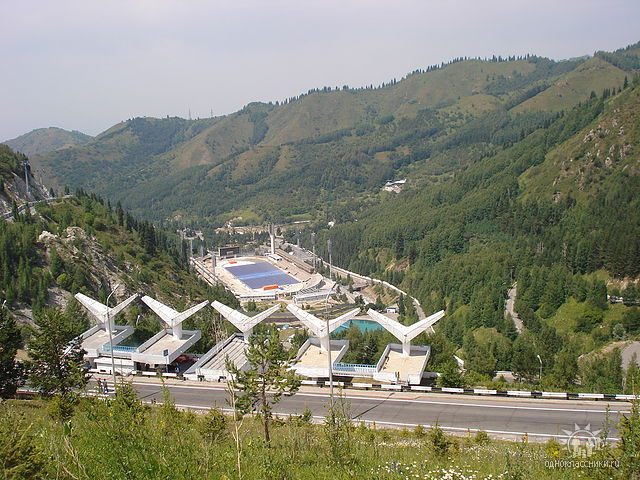Historical tour around Central Asia: following the footsteps of Great Silk Road
Duration:
7 days/ 6 nights
Season:
March - October
During this tour, you will feel yourself as a merchant marching along the Great Silk Road, as you will visit the main cities where in the former time ran the routes of the Great Silk Road. There you will see historical sightseeing, as well as the beauty of Central Asia’s nature – Sairam Ugam National Park and Issyk Kul lake.
Day 1: Almaty city tour
Meeting with guide in Almaty and transfer for city tour.
City tour starts from visit of Park of 28 Panfilov Guardsmen, named after the 28 Panfilov guards from Almaty, who died heroically defending Moscow against the Nazi invasion in 1941. The next stop is the world’s most elevated wooden church, Zenkov Cathedral, Green bazar and the Central mosque. Then we will pass through the modern highlights of the city: futuristic and busy Al-Farabi street, the Presidential palace, Monument of Independence.
Transfer to Medeo gorge, where you will have a brief stop on the huge Medeo dam, which protects the city from destructive mudflows formed on the tops of the western Tien Shan.
Getting to Shymbulak from Medeo by cable car.
The Ski Resort Shymbulak is located on a picturesque valley in the Zailiyskiy Alatau within the height 2260 m above sea level, 25 km from the centre of Almaty.
Transfer to visit Kok-Tobe mountain (the highest point of the city, located at height of 1100 meters above sea level). From its top opens the surprising panorama on mountains and the city. The highest TV-tower is located here.
18.00 Transfer for dinner at local restaurant.
19.30 Transfer to the train station. 20:18 night train to Taraz
Meal: ---
Any questions?


Day 2: Taraz - Shymkent
05:50 Arrival to Taraz. Taraz has played an enormous role as a cultural and trade centre of Kazakh Khanates and the Great Silk Road.
06.30 Breakfast on the way
After breakfast, start Taraz city tour. It will include visiting of following sightseeing:
- Regional Museum with impressive collection of balbals (stone sculptures);
- Karakhan and Dautbek Mausoleum;
- medieval bath of Cali Yunus. Exhibits of the museum of the cities of Silk Road are located here.
- The structure Tekturmas which is located at the top of a hill, near Talas river.
After city tour, you will be transferred to Shymkent.
En route visiting of Aisha Bibi and Babadzhi Hatun Mausoleums.
The Aisha Bibi mausoleum is considered as a pearl of medieval architecture by historians, architects, archaeologists, as well as representatives of UNESCO, who made this mausoleum a list of particularly valuable historical and architectural monuments of mankind. This is the only architectural monument in all of Central Asia, lined with carved terracotta. The building of the mausoleum Aisha Bibi is distinguished by the grandeur of decoration with terracotta tiles of various shapes and unrepeatable ornament. Tiles were performed by skilled craftsmen and counted up to 99 patterned compositions. At the heart of the ornaments are used vegetative and geometric motifs, in which hidden the deep philosophy of the sad legend accompanying the history of the mausoleum's appearance, which the local caretakers like to tell to the visitors here.
Located near the mausoleum of Aisha Bibi, the mausoleum of Babadzhi Khatun is a unique architectural monument of the 11th-12th centuries. The mausoleum is famous for its original 16-ribbed umbrella dome of double curvature. The umbrella ribbed covering of the dome does not have, in fact, direct analogues in contemporary Central Asian architecture. The epigraphic frieze on the portal of the mausoleum brought to us the name of the woman buried under it. According to legend, she was Aisha's nanny and accompanied her on a tragic trip. After the death of Aisha Babadzhi Khatun supported the fire on the grave of her beloved pupil. Both mausoleums are not only architectural objects, but also places of pilgrimage, as they are considered holy places in the Muslim world.
20.00 arrival to Shymkent. Accommodation in the hotel. Dinner, overnight.
Meal: ---
Day 3: Shymkent - Sayram Ugam National Park - Shymkent
09.00 Short city tour around Shymkent.
City tour starts from visiting local bazar (small bazar) and historical museum.
Historical museum of Shymkent contains relics that are of direct relevance to the history of the region. The stored things embodied not only to the history, life and culture of the ancient cities of the Great Silk Road, such as Otrar, Sairam, Turkestan, and others, but the totality of traditions, customs, arts, crafts, civilizations and special features of the spiritual identity of the Kazakhs.
Transfer to canyon Aksu (Sayram Ugam National Park) about 70 km via ancient city Sayram – the part of a Great Silk Road – visit Mausoleums of parents of Hodzha Ahmet Jassaui - Ibragim аtа and Karashash ana.
Lunch at local café.
Arrival to canyon Aksu which depth reaches 500 m. Visiting of “the Valley of thousand eyes” - a huge stone wall with set of the caves reminding eyes. The ledge of other rock is similar to heart. Sometimes the watercourse takes out a tree trunk and then the stone reminds the heart punched by an arrow on a rock.
Despite huge depth of a canyon, there is a chance to step through it. It can be made in a surprising place under the name the Devil's bridge (the Shaitan коpir) where the distance between canyon edges is narrowed to half of meter. And a bit lower on a current the river Aksu and at all disappears underground. This place name the Black hole, and it is one of the most beautiful places of Sayram Ugam.
Drive back to Shymkent.
Dinner at local restaurant. Transfer to hotel. Overnight.
Meal: ---
Day 4: Shymkent – Turkestan - Shymkent
Breakfast.
Drive to Turkestan (170 km, about 2 hours)
On the way visit Arystan Bab mausoleum, ruins of Otrar city.
According to legends Arystan Bab, a religious mystic, was the recipient of Mohammad's amanat beads or persimmon stone. Khodja Ahmed Yassaui was his pupil. Arystan Bab lived for over 400 years before his death
The ancient settlement at Otrar was first excavated in 1969. There were found brick structures, including a palace, mosques, a bath-house and ovens. First mention of Otrar or Farab (the latter name etymologically Arabic) occurs at the beginning of the ninth century. One of the residents of Otrar at that time was the philosopher Abu Nasr al Farabi. A man of encyclopaedic breadth of interest - he was a philosopher, poet, composer, linguist, mathematician, doctor, agronomist and botanist - he was referred by his students as ’the second teacher’ - meaning second only to Aristotle. There is a story about the heroic but ultimately unsuccessful defence of Otrar against Genghis Khan’s forces. Before the attack on the town, a caravan sent there by Genghis Khan in 1218 to the court of the khorezm-shah Mohammed had been plundered and then annihilated on arrival, apparently because the governor, Kair Khan Yinalchuk, suspected that among the people travelling with the caravan were too many spies and not enough traders. This well-known incident has come to be known as the Otrar catastrophe; it was the pretext by which the Mongols began their conquest of Central Asia.
Arrive to Turkestan.
Trip to Sauran.
Sauran city was functioning in XIII – XVIII centuries, and it was one of the most powerful Turkestan castles. In the middle of XIII century the city was the capital of Ak Orda. It is located 40 km in the North –West of Turkestan.
Walk to the historical monuments of the old Sauran.
En route back to Shymkent visit the mausoleum of Hodja Ahmed Yassavi.
The Mausoleum of Hodja Ahmed Yassavi is an unfinished mausoleum in the city of Turkestan, in southern Kazakhstan. The structure was commissioned in 1389 by Timur, who ruled the area as part of the expansive Timurid Empire, to replace a smaller 12th-century mausoleum of the famous Turkic poet and Sufi mystic, Khoja Ahmed Yassavi (1093–1166). However, construction was halted with the death of Timur in 1405.
The religious structure continues to draw pilgrims from across Central Asia and has come to epitomize the Kazakh national identity. It has been protected as a national monument, while UNESCO recognized it as the country's first site of patrimony, declaring it a World Heritage Site in 2003.
Drive back to Shymkent (2 hours)
Dinner, overnight at hotel.
Meal: ---
Day 5: Shymkent – Almaty
Breakfast
08.30 transfer to airport for flight to Almaty at 10.00
11.15 arrival to Almaty. Check in the hotel.
Depart to excursion at the Big Almaty Lake (about 30 km from Almaty)
Big Almaty Lake is located in gorge of river Big Almatinka, at height of 2511 m above sea level, in 28,5 km to the south from Almaty.
Lunch during excursion.
15.00 Transfer to Falconry farm “Sunkar”
Viewers will get a lot of information about the history of falconry, the biological features and the way of life of birds of prey.
16.00 transfer to airport for flight to Bishkek.
19.15 Arrival to Kyrgyzstan. Meeting the Kyrgyz guide and transfer to hotel for overnight.
Meal: ---
Day 6: Bishkek – Issyk Kul lake
Breakfast. Transfer to Issyk-Kul lake. On the way a stop in Burana Tower, a place on the Great Silk Road. Excursion. Lunch is on the way.
The historical complex Burana Tower (11th C.), the remains of Karakhanid's empire in Central Asia, where also lie the ruins of Balasagun town dated back from 9th to 14th century;
We will drive along the northern shore of Issyk-Kul lake. Upon arrival dinner and overnight in the hotel.
Overnight at hotel.
Meal: ---












Day 7: Issyk Kul - Bishkek-Almaty
After breakfast a visit to Ala Archa National Park. A walk here.
A city tour of Bishkek with visiting Central Square, Oak Park, Philharmonic Hall and Osh Bazaar. Late lunch and transfer to the airport for flight to Almaty.
Meal: ---
